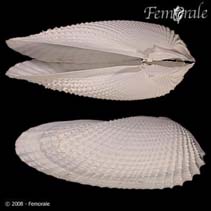Cyrtopleura costata (Linnaeus, 1758)
Angel wingWarning: DOMDocument::load(): SSL operation failed with code 1. OpenSSL Error messages: error:140770FC:SSL routines:SSL23_GET_SERVER_HELLO:unknown protocol in C:\Apache24\htdocs\includes\SpeciesSummary.lib.php on line 1236
Warning: DOMDocument::load(): Failed to enable crypto in C:\Apache24\htdocs\includes\SpeciesSummary.lib.php on line 1236
Warning: DOMDocument::load(https://sealifebase.nrm.se/webservice/AquaMaps/getAMap.php?genus=Cyrtopleura&species=costata): failed to open stream: operation failed in C:\Apache24\htdocs\includes\SpeciesSummary.lib.php on line 1236
Warning: DOMDocument::load(): I/O warning : failed to load external entity "https://sealifebase.nrm.se/webservice/AquaMaps/getAMap.php?genus=Cyrtopleura&species=costata" in C:\Apache24\htdocs\includes\SpeciesSummary.lib.php on line 1236
Classification / Names Common names | Synonyms | CoL | ITIS | WoRMS
Bivalvia | Myida | Pholadidae
Environment: milieu / climate zone / depth range / distribution range Ecology
Benthic; depth range 0 - 49 m (Ref. 83435). Tropical
Distribution Countries | FAO areas | Ecosystems | Occurrences | Introductions
Western Atlantic: Caribbean to northeast Brazil.
Length at first maturity / Size / Weight / Age
Maturity: Lm ? range ? - ? cm Max length : 18.0 cm TL male/unsexed; (Ref. 271)
Short description Morphology
Diagnostic features: Shell light, thin, elongate. Sculpture of concentric ridges and strong radial ribs. Scale-like projections form at intersections of ridges and ribs. Pair of spoon-shaped structures under umbones, called apophyses, are points of attachment of foot muscles. Colour: pure white, seldom with delicate pinkish internal coloration (Ref. 271).
It has an assumed maximum total length of 18 cm (Ref. 271). Maximum depth from Ref. 104365. It is found infaunal in compact mud or sand, from intertidal to shallow subtidal depths. Borer in mud bottoms in protected bays (Ref. 271).
Life cycle and mating behavior Maturity | Reproduction | Spawning | Eggs | Fecundity | Larvae
Members of the class Bivalvia are mostly gonochoric, some are protandric hermaphrodites. Life cycle: Embryos develop into free-swimming trocophore larvae, succeeded by the bivalve veliger, resembling a miniature clam.
Main reference
References | Coordinator | Collaborators
Carpenter, K.E. (ed.). 2002. (Ref. 271)
IUCN Red List Status (Ref. 130435)
CITES status (Ref. 108899)
Not Evaluated
CMS (Ref. 116361)
Not Evaluated
Threat to humans
Human uses
| FishSource |
Tools
More information
Internet sources
BHL | BOLD Systems | CISTI | DiscoverLife | FAO(Publication : search) | Fishipedia | GenBank (genome, nucleotide) | GloBI | Gomexsi | Google Books | Google Scholar | Google | PubMed | Tree of Life | Wikipedia (Go, Search) | Zoological Record
Estimates based on models
Preferred temperature
(Ref. 115969): 22.9 - 28, mean 25.4 (based on 426 cells).
Price category
(Ref. 80766):
Unknown.



